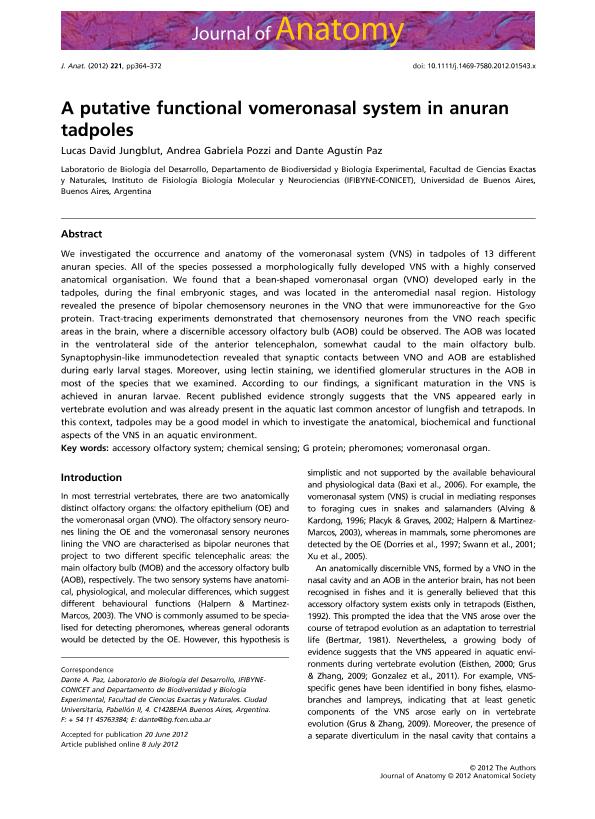Artículo
A putative functional vomeronasal system in anuran tadpoles
Fecha de publicación:
10/2012
Editorial:
Wiley
Revista:
Journal Of Anatomy
ISSN:
0021-8782
Idioma:
Inglés
Tipo de recurso:
Artículo publicado
Clasificación temática:
Resumen
We investigated the occurrence and anatomy of the vomeronasal system (VNS) in tadpoles of 13 different anuran species. All of the species possessed a morphologically fully developed VNS with a highly conserved anatomical organisation. We found that a bean-shaped vomeronasal organ (VNO) developed early in the tadpoles, during the final embryonic stages, and was located in the anteromedial nasal region. Histology revealed the presence of bipolar chemosensory neurones in the VNO that were immunoreactive for the Gαo protein. Tract-tracing experiments demonstrated that chemosensory neurones from the VNO reach specific areas in the brain, where a discernible accessory olfactory bulb (AOB) could be observed. The AOB was located in the ventrolateral side of the anterior telencephalon, somewhat caudal to the main olfactory bulb. Synaptophysin-like immunodetection revealed that synaptic contacts between VNO and AOB are established during early larval stages. Moreover, using lectin staining, we identified glomerular structures in the AOB in most of the species that we examined. According to our findings, a significant maturation in the VNS is achieved in anuran larvae. Recent published evidence strongly suggests that the VNS appeared early in vertebrate evolution and was already present in the aquatic last common ancestor of lungfish and tetrapods. In this context, tadpoles may be a good model in which to investigate the anatomical, biochemical and functional aspects of the VNS in an aquatic environment.
Palabras clave:
Amphibia
,
Olfactory System
,
Quimiodetection
Archivos asociados
Licencia
Identificadores
Colecciones
Articulos(IFIBYNE)
Articulos de INST.DE FISIOL., BIOL.MOLECULAR Y NEUROCIENCIAS
Articulos de INST.DE FISIOL., BIOL.MOLECULAR Y NEUROCIENCIAS
Citación
Jungblut, Lucas David; Pozzi, Andrea Gabriela; Paz, Dante Agustin; A putative functional vomeronasal system in anuran tadpoles; Wiley; Journal Of Anatomy; 221; 4; 10-2012; 364-372
Compartir
Altmétricas




